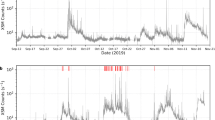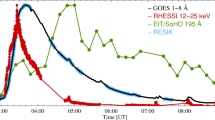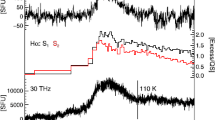Abstract
The Reuven Ramaty High Energy Solar Spectroscopic Imager (RHESSI) gives us a chance to investigate the theoretical Neupert effect using the correlation between the thermal-energy derivative and the nonthermal energy, or the thermal energy and the integral nonthermal energy. Based on this concept, we analyze four M-class RHESSI flares on 13 November 2003, 4 November 2004, 3 and 25 August 2005. According to the evolution of the temperature [T], emission measure [EM], and thermal energy [E th], each event is divided into three phases during the nonthermal-energy input [\(\frac {\mathrm{d}E_{\mathrm{nth}}}{\mathrm{d}t}\) in the units of erg s−1]. Phase 1 is identified as the interval before the temperature maximum, while after the thermal-energy maximum is phase 3, between them is phase 2. We find that these four flares show the Neupert effect in phase 1, but not in phase 3. The Neupert effect still works well in the second phase, although the cooling becomes slightly important. We define the parameter μ in the relation of \(\frac{\mathrm {d}E_{\mathrm{th}}}{\mathrm{d}t}=\mu\frac{\mathrm{d}E_{\mathrm {nth}}(t)}{\mathrm{d}t}\) or \(E_{\mathrm{th}}(t_{0})=\mu\int_{0}^{t_{0}}\frac{\mathrm{d}E_{\mathrm{nth}}(t)}{\mathrm{d}t}\,\mathrm{d}t\) when the cooling is ignored in phase 1. Considering the uncertainties in estimating the energy from the observations, it is not possible to precisely determine the fraction of the known energy in the nonthermal electrons transformed into the thermal energy of the hottest plasma observed by RHESSI. After a rough estimate of the flare volume and the assumption of the filling factor, we investigate the parameter μ in these four events. Its value ranges from 0.02 to 0.20, indicating that a small fraction (2% – 20%) of the nonthermal energy can be efficiently transformed into thermal energy, which is traced by the soft X-ray emission, and the bulk of the energy is lost possibly due to cooling.
Similar content being viewed by others
References
Cargill, P.J.: 1994, Astrophys. J. 422, 381.
Dennis, B.R., Zarro, D.M.: 1993, Solar Phys. 146, 177.
Emslie, A.G., Kucharek, H., Dennis, B.R., Gopalswamy, N., Holman, G.D., Share, G.H., Vourlidas, A., Forbes, T.G., Gallagher, P.T., Mason, G.M., Metcalf, T.R., Mewaldt, R.A., Murphy, R.J., Schwartz, R.A., Zurbuchen, T.H.: 2004, J. Geophys. Res. A 109, 10104.
Hudson, H.S.: 1991, Bull. Am. Astron. Soc. 23, 1064.
Kahler, S.W., Meekins, J.F., Kreplin, R.W., Bowyer, C.S.: 1970, Astrophys. J. 162, 293.
Lin, R.P., Dennis, B.R., Hurford, G.J., Smith, D.M., Zehnder, A., Harvey, P.R., Curtis, D.W., Pankow, D., Turin, P., Bester, M., Csillaghy, A., Lewis, M., Madden, N., van Beek, H.F., Appleby, M., Raudorf, T., McTiernan, J., Ramaty, R., Schmahl, E., Schwartz, R., Krucker, S., Abiad, R., Quinn, T., Berg, P., Hashii, M., Sterling, R., Jackson, R., Pratt, R., Campbell, R.D., Malone, D., Landis, D., Barrington-Leigh, C.P., Slassi-Sennou, S., Cork, C., Clark, D., Amato, D., Orwig, L., Boyle, R., Banks, I.S., Shirey, K., Tolbert, A.K., Zarro, D., Snow, F., Thomsen, K., Henneck, R., McHedlishvili, A., Ming, P., Fivian, M., Jordan, J., Wanner, R., Crubb, J., Preble, J., Matranga, M., Benz, A., Hudson, H., Canfield, R.C., Holman, G.D., Crannell, C., Kosugi, T., Emslie, A.G., Vilmer, N., Brown, J.C., Johns-Krull, C., Aschwanden, M., Metcalf, T., Conway, A.: 2002, Solar Phys. 210, 3.
Liu, W., Liu, S., Jiang, Y.W., Petrosian, V.: 2006, Astrophys. J. 649, 1124.
Neupert, W.M.: 1968, Astrophys. J. Lett. 153, L59.
Ning, Z.: 2008a, Solar Phys. 248, 99.
Ning, Z.: 2008b, Astrophys. J. 686, 674.
Porter, L.J., Klimchuk, J.A.: 1995, Astrophys. J. 454, 499.
Saint-Hilaire, P., Benz, A.O.: 2005, Astron. Astrophys. 435, 743.
Smith, D.M., Lin, R.P., Turin, P., Curtis, D.W., Primbsch, J.H., Campbell, R.D., Abiad, R., Schroeder, P., Cork, C.P., Hull, E.L., Landis, D.A., Madden, N.W., Malone, D., Pehl, R.H., Raudorf, T., Sangsingkeow, P., Boyle, R., Banks, I.S., Shirey, K., Schwartz, R.: 2002, Solar Phys. 210, 33.
Sui, L., Holman, G.D., Dennis, B.R.: 2005, Astrophys. J. 626, 1102.
Tanaka, K., Zirin, H.: 1985, Astrophys. J. 299, 1036.
Veronig, A., Vršnak, B., Dennis, B.R., Temmer, M., Hanslmeier, A., Magdalenić, J.: 2002, Astron. Astrophys. 392, 699.
Veronig, A.M., Brown, J.C., Dennis, B.R., Schwartz, R.A., Sui, L., Tolbert, A.K.: 2005, Astrophys. J. 621, 482.
White, S.M., Thomas, R.J., Schwartz, R.A.: 2005, Solar Phys. 227, 231.
Author information
Authors and Affiliations
Corresponding author
Rights and permissions
About this article
Cite this article
Ning, Z., Cao, W. Investigation of the Neupert Effect in the Various Intervals of Solar Flares. Sol Phys 264, 329–344 (2010). https://doi.org/10.1007/s11207-010-9589-1
Received:
Accepted:
Published:
Issue Date:
DOI: https://doi.org/10.1007/s11207-010-9589-1




